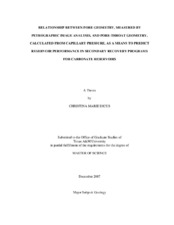| dc.description.abstract | The purpose of this study was first to develop a method by which a detailed
porosity classification system could be utilized to understand the relationship between
pore/pore-throat geometry, genetic porosity type, and facies. Additionally, this study
investigated the relationships between pore/pore-throat geometry, petrophysical
parameters, and reservoir performance characteristics. This study focused on the
Jurassic Smackover reservoir rocks of Grayson field, Columbia County, Arkansas.
This three part study developed an adapted genetic carbonate pore type
classification system, through which the Grayson reservoir rocks were uniquely
categorized by a percent-factor, describing the effect of diagenetic events on the
preservation of original depositional texture, and a second factor describing if the most
significant diagenetic event resulted in porosity enhancement or reduction. The second
part used petrographic image analysis and mercury-injection capillary pressure tests to
calculate pore/pore-throat sizes. From these data sets pore/pore-throat sizes were
compared to facies, pore type, and each other showing that pore-throat size is controlled by pore type and that pore size is controlled primarily by facies. When compared with
each other, a pore size range can be estimated if the pore type and the median pore-throat
aperture are known.
Capillary pressure data was also used to understand the behavior of the
dependent rock properties (porosity, permeability, and wettability), and it was
determined that size-reduced samples, regardless of facies, tend to show similar
dependent rock property behavior, but size-enhanced samples show dispersion. Finally,
capillary pressure data was used to understand fluid flow behavior of pore types and
facies. Oncolitic grainstone samples show unpredictable fluid flow behavior compared
to oolitic grainstone samples, yet oncolitic grainstone samples will move a higher
percentage of fluid. Size-enhanced samples showed heterogeneous fluid flow behavior
while the size-reduced samples could be grouped by the number of modes of pore-throat
sizes.
Finally, this study utilized petrographic image analysis to determine if 2-
dimensional porosity values could be calculated and compared to porosity values from
3-dimensional porosity techniques. The complex, heterogeneous pore network found in
the Grayson reservoir rocks prevents the use of petrographic image analysis as a porosity
calculation technique. | en |


